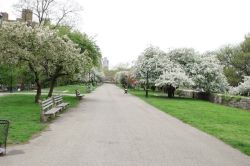Riverside Park
View all monuments in NYC Parks, as well as temporary public art installations on our NYC Public Art Map and Guide.
Joan of Arc Memorial
| Artist: | Anna Vaughn Hyatt Huntington |
| Dedicated: | December 6, 1915 |
| Location: | Riverside Drive at 93rd Street |
Artwork History
Who is this monument dedicated to?
This impressive bronze equestrian sculpture of 15th century French patriot and martyr Joan of Arc (1411–1431). Created by the eminent artist and art patron Anna Vaughn Hyatt Huntington (1876–1973), the piece was dedicated in 1915.
Jeanne La Pucelle, later known as Joan of Arc, was a peasant maiden said to have been divinely inspired to help liberate the French from English rule. Through her determination, she was able to gain an audience with the Dauphin of France, later to be King Charles VII, at the time when the city of Orleans was under siege. Charles appointed her commander-in-chief of a small provisional army, which under her inspired command forced the English to withdraw in 1429. With the siege lifted, the Dauphin was crowned in Reims Cathedral, with Joan seated in the place of honor next to him.
Though a popular figure, Joan was restrained by the new King from marching on Paris. In 1430, while conducting an unofficial campaign, she was captured by Burgundian soldiers at Compiegne and sold to the English, who charged her with witchcraft and heresy. She was subjected to a long trial in a French ecclesiastical and was eventually found guilty and condemned to death. On May 31, 1431, she was burned at the stake. Twenty years later an investigation into Joan’s trial proceedings led to the annulment of her sentence. On May 16, 1920, nearly 500 years later, Jeanne la Pucelle was canonized as Saint Joan by Pope Benedict XV.
How was this created?
In New York, a prominent group of citizens formed a Joan of Arc monument committee in 1909. Their efforts coincided with those of a young sculptor, Anna Hyatt Huntington, to create a sculpture of Joan. Her first version, in which she emphasized “the spiritual rather than the warlike point of view,” was submitted to the prestigious Salon in Paris. It received an honorable mention from the jury, nevertheless skeptical that such an accomplished work of art could have been made solely by a woman.
The New York monument committee, headed by J. Sanford Saltus, was so impressed by her work, that they awarded her the commission. Architect John van Pelt was retained to design the pedestal, which is made of Mohegan granite composed of Gothic-style blind arches, decorated with coats of arms. A few limestone blocks from the tower in Rouen where Joan of Arc had been imprisoned were incorporated into the base. Van Pelt situated the monument at the top of the steps in the park island at 93rd Street and Riverside and had planted a screen of trees to disguise the buildings.
Huntington’s version is both heroic and infused with naturalistic detail. For Joan’s armor, she conducted research at the arms and armory division of the Metropolitan Museum of Art; the refinement of the equine anatomy was based on a horse borrowed from the fire department of her native town of Gloucester, Massachusetts. Her niece posed astride a barrel, as she modeled the figure, first nude, then in costume.
On December 6, 1915, the sculpture, the first commemorative sculptor of a woman in New York City, was unveiled in an elaborate ceremony. It included a military band and French Ambassador Jean J. Jusserand and Mrs. Thomas Alva Edison were among those selected to pull the cord that released the shroud. Huntington had a long and illustrious career and sculpted the statue of the Cuban patriot, José Martí (1965), which stands at Central Park South and Avenue of the Americas. Following World War I, replicas of the Joan of Arc sculpture were placed in 1921 in Gloucester, Blois, France, and Quebec City, Canada, and in 1926 an additional replica was installed in front of the Palace of the Legion of Honor in Lincoln Park, San Francisco.
In 1939, Parks repaired Joan’s sword, which had been broken, repatined the bronze statue, and repaired the staircase. In 1987 the sculpture was again conserved through the Municipal Art Society’s Adopt-A-Monument Program.
Artwork Details
| Description: | Equestrian figure (over life-size) on integral plinth on pedestal |
| Architect: | John V. Van Pelt |
| Materials: | Bronze, Mohegan granite |
| Dimensions: | Total H: 20'4" W: 6'1" D: 12'3" |
| Donor: | Joan of Arc Statue Committee |
| Cast: | 1915 |
Inscription
JOAN OF ARC / BORN AT / DOMREMY FRANCE / JANUARY 6TH,1411 / BURNED AT THE STAKE AT / ROUEN, FRANCE / MAY 30TH, 1431/ERECTED BY / THE JOAN OF ARC STATUE COMMITTEE / IN THE CITY OF NEW YORK 1915.
Please note, the NAME field includes a primary designation as well as alternate namingsoften in common or popular usage. The DEDICATED field refers to the most recent dedication, most often, butnot necessarily the original dedication date. If the monument did not have a formal dedication, the yearlisted reflects the date of installation.
For more information, please contact Art & Antiquities at (212) 360-8163.
Check out your park's Vital Signs
Clean & Safe
Green & Resilient
Empowered & Engaged Users
Share your feedback or learn more about how this park is part of a
Vital Park System

Know Before You Go
Related inquiries may be sent to boatbasin@parks.nyc.gov
Related inquiries may be sent to boatbasin@parks.nyc.gov






